Vortrag
Nicoletta Leonardi:
Umberto Ellero’s Teleiconotipia: an intermedia perspective on photography and policing in colonial Italy

In 1911, Italian police commissioner Umberto Ellero, photography instructor at the Scuola di Polizia Scientifica and author of a manual on the use of photography in police investigations and trial proceedings, first experimented his method of phototelegraphy. Ellero’s Teleiconotipia promised to overcome the technical challenge of expeditiously and accurately converting photographs into electric impulses, and vice versa, by rehabilitating an old technique used in the 1880s for the typographic reproduction of photographs for embroidery. Just like other similar contemporary processes, the method consisted in the analysis and coding of the original image by the human eye and in the transmission of coded information via telegraph signals. At the receiving end, a reversal of the process would take place. Ellero’s patent responded to the need for circulating faster than by regular post mugshots of criminals and unrecorded suspects, as well as photographs of purloined goods (the Mona Lisa was stolen from the Louvre Museum in 1911). Ellero claimed that with his method a reliable and accurate life-size photograph could be transmitted in three hours. At the time of Italy’s colonial invasion of Libya (1911-1912), which was preceded by a wide national propaganda campaign, it is extremely significant that the first two tele-transmitted photographs reported by Ellero were a portrait of King Victor Emmanuel III and the profile mugshot of ‘an arab’, a perfect embodiment of Cesare Lombroso’s atavistic criminal. Due to its complex process of decoding and reconstitution, Ellero’s invention was scarcely applied by the Italian police and became obsolete in the late 1920s with the introduction of the simple, fast and widely marketable Karolus-Telefunken phototelegraphy system. Resulting from the intersection of photography, telegraphy, scientific policing and criminal anthropology, teleiconotypy offers an example of how, in order to fully understand the role of photographs in our society, the material stuff as well as the material and immaterial networks that make up their processes, we need to position photography within more comprehensive media histories that point to the processes of convergence between different media and technologies and look at the complex relationship between rupture and continuity, between the old and the new, between successful innovations and failures. In looking at the colonial narratives and racist stereotypes at work in Ellero’s introduction of teleiconotypy as an evidentiary and surveillance technology of colonial policing, my aim is to offer an escape from the otherwise limiting boundaries of historical single media narratives based on the idea of technological revolutions bringing back to light the marginalised episode of an unsuccessful but culturally significant intermedia invention.
Nicoletta Leonardi is a full professor at Brera Academy of Fine Arts (Milan), where she teaches photographic history and curates the photographic collection. She is also curator of the photographic collection at Albertina Academy of Fine Arts (Turin). Her work is based on the overcoming of the history of photography as a medium-specific discipline in favour of a systemic approach to the study of different media as an integrated field of technologies, networks, and artefacts. Her writings have been published extensively in exhibition catalogues, peer reviewed journals and edited volumes. She has authored two monographs, Il paesaggio americano dell’Ottocento: pittori, fotografi, pubblico (Donzelli 2003) and Fotografia e materialità in Italia: Vaccari, Guidi, Cresci, Ghirri (Postmedia 2013), and co-edited (with Simone Natale) Photography and Other Media in the Nineteenth Century (Penn State UP 2018). Before completing her PhD at UCL, she was a Fulbright Fellow at Columbia University.
17. November 2022, 11:00 Uhr
This event will take place in a hybrid format.
If you would like to participate in person (limited places available), please email:julia.biel@khi.fi.it
Venue
Palazzo Grifoni Budini Gattai
Via dei Servi 51
50122 Firenze, Italia
To participate online please register in advance via Zoom: https://zoom.us/meeting/register/tJ0vc-ugpjwvHtdKnUwXlSX6znK5RvNc8PW5After registering, you will receive a confirmation email containing information about joining the meeting.
Hinweis
Diese Veranstaltung wird durch Fotografien und/oder Videoaufnahmen dokumentiert. Falls es nicht Ihre Zustimmung findet, dass das Kunsthistorische Institut in Florenz Aufnahmen, auf denen Sie erkennbar abgebildet sein könnten, für die Veranstaltungsdokumentation und Öffentlichkeitsarbeit (z.B. Social Media) verwendet, bitten wir um eine entsprechende Rückmeldung.


